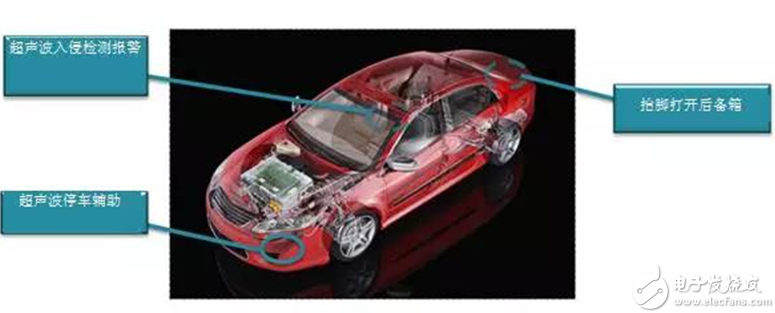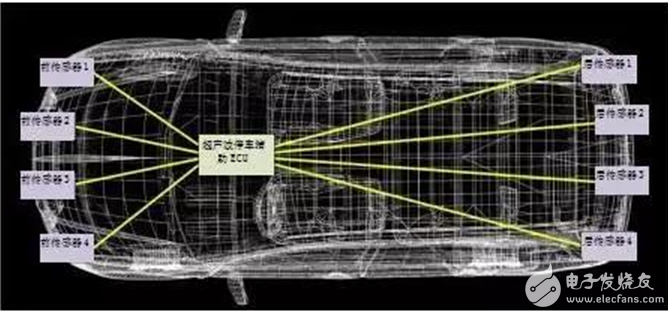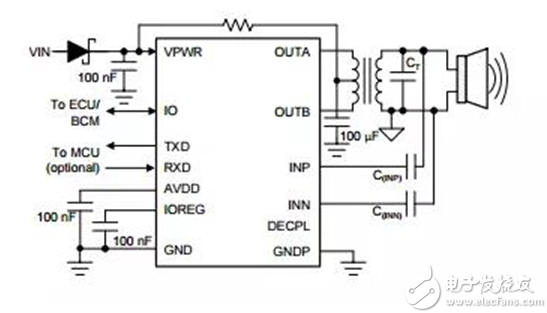For many years, ultrasonic sensors have been widely used in passenger vehicles such as ultrasonic parking assistance to help vehicles detect surrounding objects at low speeds. In addition, kicking the trunk and intrusion detection alarms are two emerging applications for ultrasonic sensors. As shown in Figure 1. This article will explain in detail why and how these three applications use ultrasonic sensors.

Figure 1: Ultrasonic sensor for passenger cars
Ultrasonic parking assist system
Ultrasonic parking assistance is also known as parking assist systems, parking guidance systems, and reverse assist. These systems enable automatic parking from simple detection of surrounding objects and alerting the driver by sound to virtually no human intervention. Typically, these systems have 4-16 sensors that are cleverly mounted around the body to provide the required inspection coverage, as shown in Figure 2.

Figure 2: Ultrasonic Parking Assist Star Configuration with PGA460-Q1
Engineers designing these types of applications should seek integrated circuits that drive ultrasonic sensors (transmitters) while receiving, conditioning, and processing ultrasonic echoes that determine the distance between the object and the vehicle. For example, the PGA460-Q1 is capable of reliably detecting International Standards Organization (ISO) rods up to 5 meters in distance (for polyvinyl chloride (PVC) tubes for ultrasonic parking assistance as a performance standard). The device also passed stringent electrostatic discharge (ESD) and high current injection (BCI) tests, which are routine tests performed during the development of ultrasonic parking assist systems.
As original equipment manufacturers (OEMs) face the need to increase the number of ultrasonic sensors per vehicle, the cost pressure of ultrasonic parking assistance will continue to increase in the coming years. The PGA460-Q1 is able to provide a competitive cost structure for high-volume Tier 1 suppliers.
Common requirements for ultrasonic parking assist modules include:
The ability to detect objects from 30 cm to 5 m.
The Time Command Interface (TCI) or the Local Interconnect Network (LIN) communication from the module to the local electronic control unit or directly to the Body Control Module (BCM) (bus configuration).
To meet the needs of self-driving cars, short- and long-distance object detection standards will become more stringent. Starting in 2025, the ultrasound module will have to be able to detect objects from 10 cm to 7 m. Improvements in analog front end (AFE) sensitivity and drive methods by semiconductor suppliers are critical to meeting these detection distance requirements.
TCI and LIN are the two most common communication interfaces in today's ultrasonic parking assistance systems. However, with the improved visual processing capabilities of the Automotive Advanced Driver Assistance System (ADAS), higher speed protocols such as Peripheral Sensor Interface (PSI) 5, Distributed System Interface (DSI) 3 or Controller Area Network (CAN) are expected to be applied. To transmit a large amount of ultrasonic echo data.
Kicking the open trunk
The kicker opening trunk is also known as the smart trunk opening system. This feature allows the owner to place his foot under the rear bumper without having to use both hands, just kicking the foot to open the trunk of the car, as shown in Figure 3.

Figure 3: The kicker opens the trunk
The traditional kick-open trunk system uses a capacitive sensor strip at the bottom of the bumper. But many automotive Tier 1 suppliers are exploring the use of ultrasonic sensing technology in this application, and some systems have been mass produced. Compared with capacitive sensing, the advantage of ultrasonic sensing is the reliability and robustness under the influence of environmental factors such as dirt and water. Capacitive sensing is very sensitive to environmental factors. If the body is dirty, this function may not work properly. .
Common requirements for ultrasonic solutions for kick-open systems include:
Ability to detect objects from 15 cm to 1 m
Low quiescent current
Working properly with 12V car battery
Let us introduce these requirements one by one.
Object detection from 15 cm to 1 m
One of the challenges of using ultrasonic sensing technology to kick the foot to open the trunk is the close range detection range. The ability of an ultrasonic sensor to accurately detect near-field objects depends on the quality of the sensor and the sensor's specifications, drive method and design, and the performance of the receive path (AFE and digital processing).
High-quality sensors, such as Murata's MA58MF14-7N, have more stable and reliable attenuation or "ringing" during the sensor excitation phase. By choosing a high-quality sensor, you can reduce the length of the decay time and more accurately predict the stability of the attenuation.
The method and design of the sensor driver will significantly affect the ultrasonic attenuation period and curve. In kick-off open trunk applications where near-field performance is required, TI recommends using a transformer-driven topology. Figure 4 is an example of a transformer drive schematic using PGA460-Q1.

Figure 4: PGA460-Q1 transformer drive schematic
When the transformer is used to increase the power supply voltage to activate the sensor, the attenuation curve is more stable and measurable, which makes the close-range object detection performance better.
Finally, the performance of AFE and digital processing can also affect object detection at close and long distances. For example, the PGA460-Q1 features a low noise amplifier with a programmable time-varying gain stage embedded in a 12-bit successive approximation register analog-to-digital converter. Low-noise amplifiers reduce the noise of the received signal, and the time-varying gain characteristics of the programmable gain amplifier allow for smaller gains for near-field objects and larger gains for far-field object detection. You can store the gain curve settings in the registers in an electrically erasable programmable read only memory (EEPROM).
Low quiescent current
Since the kicker opening ultrasonic sensor must be operated with the car turned off, the system quiescent current is very important and is an OEM's concern. The PGA460-Q1 has a sleep mode of ~500μA current consumption, which can be used intermittently to achieve the necessary level of current consumption throughout the system.
Working properly with 12V car battery
The PGA460-Q1 device is designed to operate from an input voltage range of 6V to 28V. In a kick-open trunk application, the PGA460-Q1 device is directly connected to the car battery. Proper external component protection, such as transient voltage suppression (TVS) diodes, helps protect the device from battery transients and reverse battery currents.
Intrusion detection alarm
In Europe, intrusion detection alarms are optional equipment for consumers when they purchase a car or after installing a car. When the car is turned off and docked, these alarms will use an ultrasonic sensor to detect any movement inside the car. This alarm is used as a backup system for the main alarm system and will also give an alarm if the child or pet moves inside the vehicle. Depending on the added security and security, consumers often get insurance discounts because their vehicles have this feature.
Most systems use one or two ultrasonic transmitters and one or two receivers. Ultrasonic sensors such as the PGA460-Q1 can drive and receive one transmitter and one receiver, so one or two PGA460-Q1 devices may be required.
to sum up
Although these three applications are most commonly used with ultrasonic sensors, Tier 1 suppliers and original equipment manufacturers are developing additional applications such as gull-wing doors, blind spot detection systems, and forward active collision avoidance systems. Do you also know about other automotive applications that use ultrasonic sensors? Please comment below.
Can be applied to all kinds of supermarkets, chain store POS ticket printing It can be used for catering, entertainment, automatic inquiry, automatic number picking and other bill printing Features: Adopt high-performance imported Thermal Printer core Simple and practical easy loading paper structure Optional Centronics parallel interface or RS-232 serial interface Speed up to 100mm/s Both parallel and serial interfaces Support nine kinds of barcode printing Support large print, center print Supports a variety of command systems and drivers
80Mm Thermal Printer,Thermal Inkjet Printer,Portable Thermal Printer,Thermal Sticker Printer
ShengXiaoBang(GZ) Material Union Technology Co.Ltd , https://www.sxbgz.com